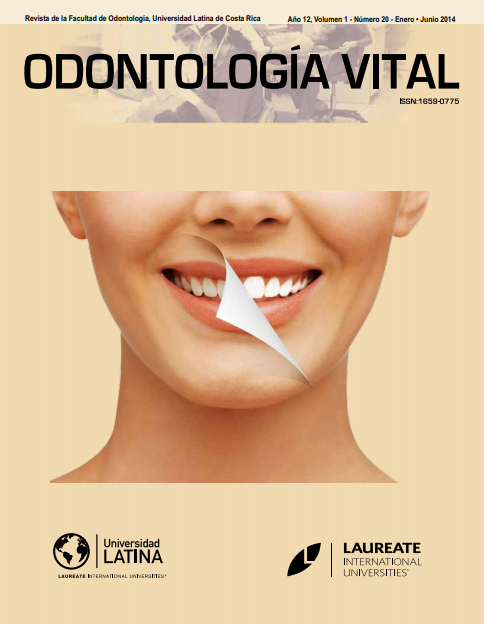Effectiveness of the Chlorhexidine Gluconate
DOI:
https://doi.org/10.59334/ROV.v1i20.297Keywords:
Chlorhexidine gluconate, invitro, oral cavity, effectivenessAbstract
The main objective of the research was to analyze the in vitro effectiveness of chlorhexidine gluconate mouthwash at different concentrations and spray the same at 0.12% on the microbial flora of the oral cavity. It is of great interest to study whether is equally effective mouthwash atomizer and chlorhexidine gluconate 0.12 % as well as if dilute chlorhexidine gluconate 0,12 % in three quarters with water still has the same effectiveness. To check these five microorganisms were chosen in the oral cavity, first an initial count of the number of microorganisms, then the previously mentioned antiseptic handling and presentation concentration was applied, and finally a final count is performed in order to compare results and demonstrate its effectiveness. It was shown that both pure and diluted mouthwash having the same effectiveness, and this is lower than that presented by the spray. As mentioned above, one can conclude that the mouthwash and spray chlorhexidine gluconate 0,12 % do not have the same effectiveness, being more effective the spray.
Downloads
References
Aguilera M., Romano E., Ramos N. Rojas L. (2011). Sensibilidad del Streptococcusmutansa tres enjuagues bucales comerciales (Estudio in vitro). Odus científica. Está indicado en: volumen 12, número 1, de la página 7 a la 13.
Bascones A., Morante S. (2006). Antisépticos orales. Revisión de la literatura y perspectiva actual. Avances periodoncia e implantología. Está indicado en: volumen 8, número 1, de la página 31 a la 59. https://doi.org/10.4321/S1699-65852006000100004
Bojorquez Y. (2008). Efectos del spray de clorhexidina al 0.12% en pacientes con periodontitis crónica durante la etapa de mantenimiento. Tesis doctoral no publicada. Universidad de Granada, Nicaragua.
Calsina G. y Serrano J. (2005). ¿Existen realmente diferencias clínicas entre las distintas concentraciones de clorhexidina? Comparación de colutorios. RCOE. Está indicado en: volumen 10, número 4, de la página 4 57 a la 464. https://doi.org/10.4321/S1138-123X2005000400007
Clavero J., Baca P., Junco P, González M. (2003). Effects of 0.2% chlorhexidine spray applied once or twice daily on plaque accumulation and gingival inflammation in a geriatric population. Journal of clinical periodontology. Está indicado en: volumen 30, número 9, de la página 773 a la 777. https://doi.org/10.1034/j.1600-051X.2003.00365.x
Hernández R., Fernández C., Baptista P. (2010). Metodología de la investigación. (5ª ed.). México: McGraw-Hill Interamericana.
Laprade, N. (2012, noviembre). Entrevista con María Laura Arias Echandi, directora del laboratorio de alimentos y aguas de la Facultad de Microbiología de la Universidad de Costa Rica.
Liébana J. (2002). Microbiología oral. (2 Ed). México: McGraw-Hill Interamericana.
Llovera JM., (2008). Clorhexidina: Un antiséptico de nuestros tiempos. Consideraciones útiles para nuestra práctica clínica. Revisiones SEMG. Está indicado en: 104, pp. 95-103
Marsh PD. Martin M., (2012). Microbiología oral. (5 Ed). Ed: Amolca Colombia.
Montiel J., Almerich J. (2002). Estudio de la eficacia de dos tratamientos anti placa y antigingivitis es un grupo de discapacitados psíquicos. Medicina oral. Está indicado en: volumen 7, número 2, pp.136-143
Morante S. (2003). Valoración cruzada y a doble ciego, mediante el modelo de gingivitis experimental, de la eficacia de tres colutorios de clorhexidina sin alcohol frente la prevención de gingivitis y a la neo formación de placa supra gingival. Tesis doctoral no publicada, Universidad Complutense de Madrid, Madrid, España.
Muñoz J., Gómez P., Moreno A. (2010). Efecto antibacteriano en cinco antisépticos de uso en cavidad bucal. Acta odontológica venezolana. Está indicado en: volumen 49, número 1, pp.1-15.
NewmanM., Takei H., Klokkevold P., Carranza F. (2010). Carranza Periodontologia clínica. (10ª Ed.). México: McGraw-Hill Interamericana.
Stiefel DJ. (2002). Dental care considerations for disable adults.Speccare dentist. Está indicado en: volumen 22, número 3, pp. 26-32.
Stoeken J, Versteeg P., Rosema N., Timmerman M., Van der Velden U., Van der WeijdenG. (2007). Inhibition of "De Novo" Plaque Formation With 0.12% Chlorhexidine Spray Compared to 0.2% Spray and 0.2% Chlorhexidine Mouthwash.Journal of clinicalperiodontology. Está indicado en: volumen 78, número 5, pp. 899-904. https://doi.org/10.1902/jop.2007.060089
Ucar A., Rojas G, Ballester A. (2007). Acción de agentes químicos en la eliminación de Cándida albicans sobre prótesis dentales. Acta odontológica venezolana. Está indicado en: volumen 45, número 2, de la página 1 a la 9
Yevenes I., Reyes J., Campos N., Saragoni V. (2002). Efecto inhibitorio en placa microbiana y propiedades antibacterianas de enjuagatorios de clorhexidina. Avances en periodoncia e implantología.Está indicado en: volumen 15, número 1, pp.19-24. https://doi.org/10.4321/S1699-65852003000100003
Downloads
Published
How to Cite
Issue
Section
License
Copyright (c) 2014 Nicole Laprade Camacho, Rodolfo Hernández Goyenaga, Maria Laura Arias Echandi and Ana Catalina Valverde Tinoco

This work is licensed under a Creative Commons Attribution 4.0 International License.
Authors who publish with Odontología Vital agree to the following terms:
- Authors retain the copyright and grant Universidad Latina de Costa Rica the right of first publication, with the work simultaneously licensed under a Creative Commons Attribution 4.0 International license (CC BY 4.0) that allows others to share the work with an acknowledgement of the work's authorship and initial publication in this journal.
- Authors are able to enter into separate, additional contractual arrangements for the non-exclusive distribution of the Odontología Vital's published version of the work (e.g., post it to an institutional repository or publish it in a book), with an acknowledgement of its initial publication.
- Authors are permitted and encouraged to post their work online (e.g., in institutional repositories or on their website) prior to and during the submission process, as it can lead to productive exchanges, as well as earlier and greater citation of published work.
Métricas alternativas











